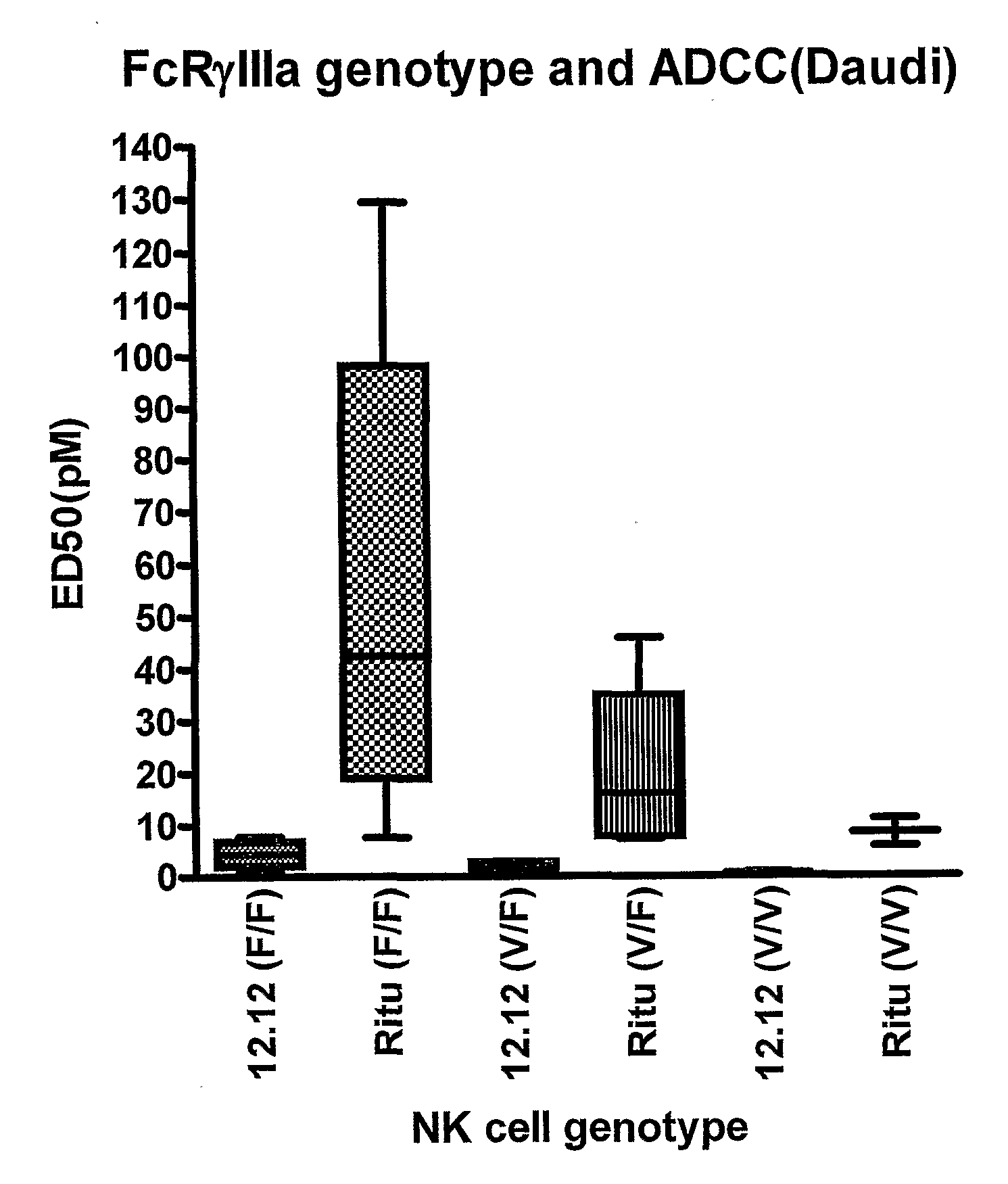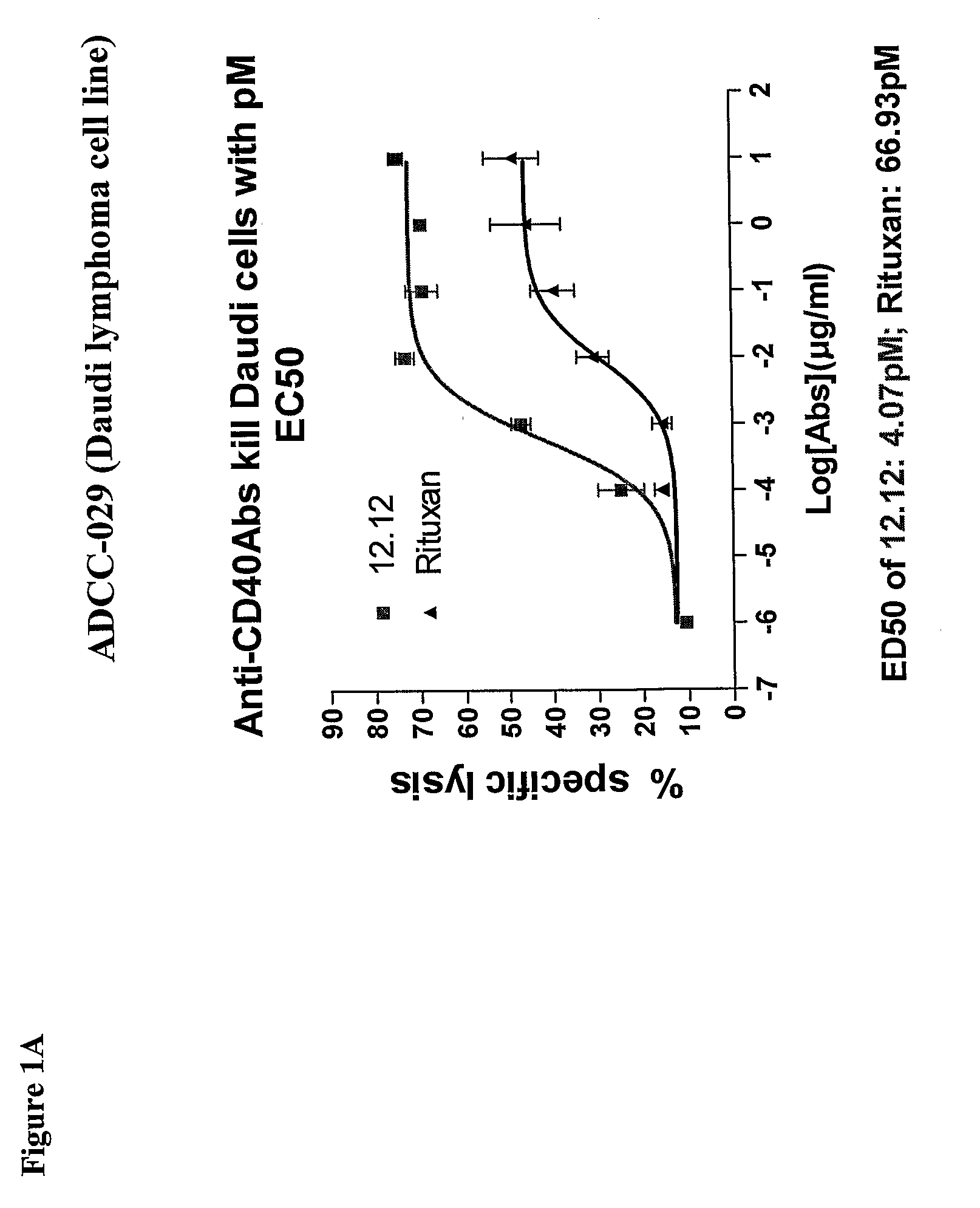Uses of Anti-cd40 antibodies
an anti-cd40 and anti-cd40 technology, applied in the field of anti-cd40 antibodies, can solve the problems of uncompletely known mechanisms of cd40l-mediated cd40 signaling leading to survival versus cell death responses of malignant b-cells
- Summary
- Abstract
- Description
- Claims
- Application Information
AI Technical Summary
Benefits of technology
Problems solved by technology
Method used
Image
Examples
example 1
Analysis of ADCC in Cell Lines
[0278]CHIR-12.12 and rituximab were compared for their relative ADCC activity against a variety of malignant B-cell lines expressing both CD40 and CD20 antigens, including lymphoma cell lines (Daudi, Namalwa), multiple myeloma cell lines (ARH77, IM-9), a B-ALL cell line (CCRF-SB), and a B-CLL cell line (EHEB).
[0279]The ADCC efficacy and potency measured as maximum percent lysis and ED50, respectively, were compared for CHIR-12.12 and rituximab. The results of these experiments are shown in FIGS. 1A-1F. For all target cell lines, CHIR-12.12 was a more potent and efficacious mediator of ADCC than rituximab. In the six cell lines tested, the number of cell surface CD20 molecules per cell were 2.6 to 30.8-fold higher than CD40. These data show that despite displaying fewer CD40 molecules than CD20, malignant B-cell lines are more effectively lysed by CHIR-12.12 than rituximab.
example 2
Analysis of ADCC in CLL Patient Cells
[0280]The relative ADCC activity of CHIR-12.12 and rituximab against ex vivo primary CLL cells from 8 patients was compared. CHIR-12.12 exhibited greater ADCC than rituximab against CLL from all patients (see FIG. 2A-D and FIG. 3). The average percent maximum lysis by CHIR-12.12 and rituximab were 49±16% and 31±14%, respectively. CHIR-12.12 was greater than 10-fold more potent than rituximab, as measured by ED50 values (14.1 pM versus 155.5 pM, respectively).
Antibody-Dependent Cellular Cytotoxicity (ADCC) Experiment Design
[0281]Target cells: CLL patient cells, 5000 / well. Effector cells: purified normal human NK cells, 50,000 / well. E:T ratio: 10. Abs concentration: 0.00001, 0.0001, 0.001, 0.01, 0.1, 1 and 10 μg / ml. Incubation time: 4 hrs. Culture medium: RPMI (w / o Phenol red)+10% FBS+1% P / S. Culture device: 96-well round bottom plate. Readout: Calcein AM release measured by Arbitrary Fluorescent Units (AFU) with 485 nm excitation / 535 nm emission. ...
example 3
Quantitation of Cell-Surface CD40 and CD20 Molecules
[0283]Quantitative CD20 and CD40 density on CLL cells (Example 3) and the degree of antibody internalization (Example 4) were investigated as potential reasons for the above-described difference in ADCC activity. The relative ADCC activity of CHIR-12.12 and rituximab against ex vivo primary CLL cells from 9 patients was then compared. CHIR-12.12 exhibited greater ADCC than rituximab against CLL from all patients (see FIG. 2A-D and FIG. 3). The average percent maximum lysis by CHIR-12.12 and rituximab were 48±15% and 30±14%, respectively. CHIR-12.12 was greater than 10-fold more potent than rituximab, as measured by ED50 values (13.2 pM versus 147.2 pM, respectively, FIG. 6).
[0284]The greater ADCC activity and efficacy of CHIR-12.12 was not dependent on a higher density of cell surface CD40 molecules, as there were 1.3- to 14-fold higher numbers of CD20 than CD40 molecules on the cell surface (see FIG. 5 and FIG. 6).
Methods
[0285]Cel...
PUM
| Property | Measurement | Unit |
|---|---|---|
| time | aaaaa | aaaaa |
| time | aaaaa | aaaaa |
| time | aaaaa | aaaaa |
Abstract
Description
Claims
Application Information
 Login to View More
Login to View More - R&D
- Intellectual Property
- Life Sciences
- Materials
- Tech Scout
- Unparalleled Data Quality
- Higher Quality Content
- 60% Fewer Hallucinations
Browse by: Latest US Patents, China's latest patents, Technical Efficacy Thesaurus, Application Domain, Technology Topic, Popular Technical Reports.
© 2025 PatSnap. All rights reserved.Legal|Privacy policy|Modern Slavery Act Transparency Statement|Sitemap|About US| Contact US: help@patsnap.com



